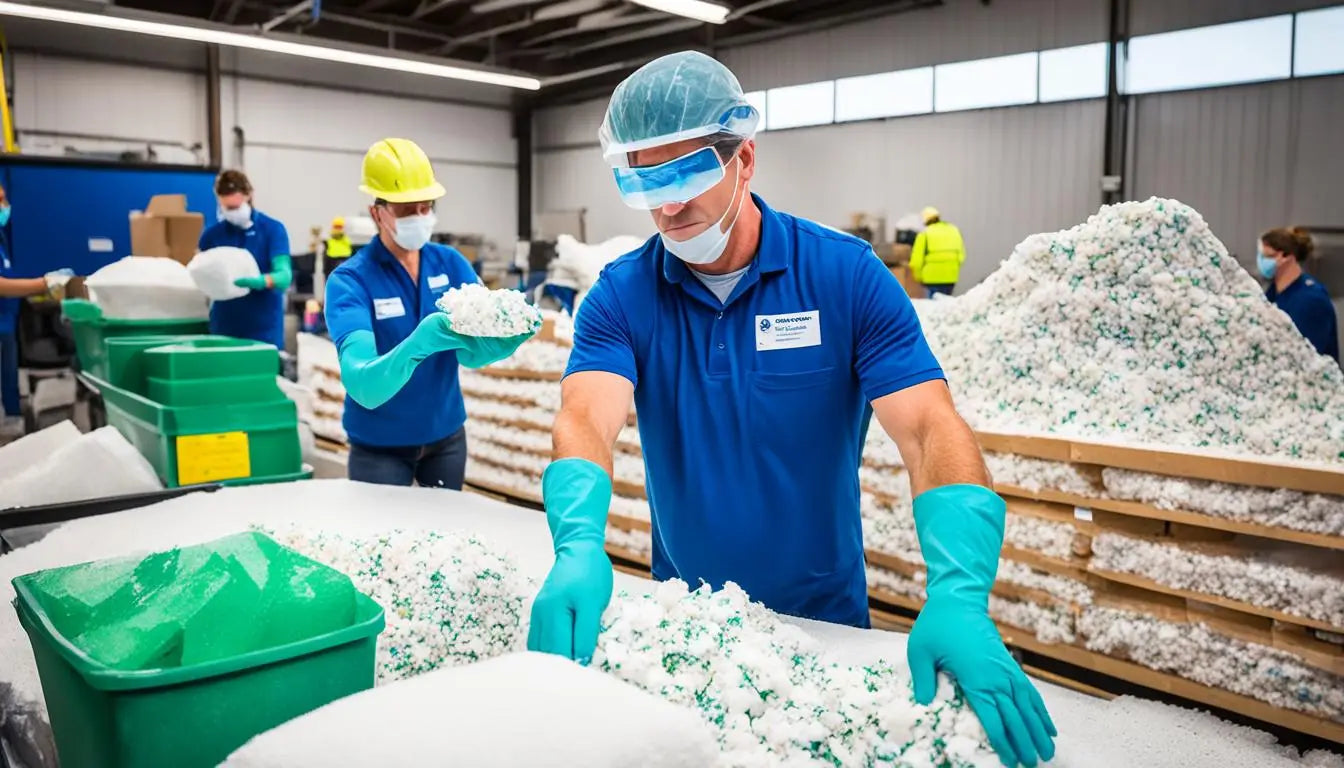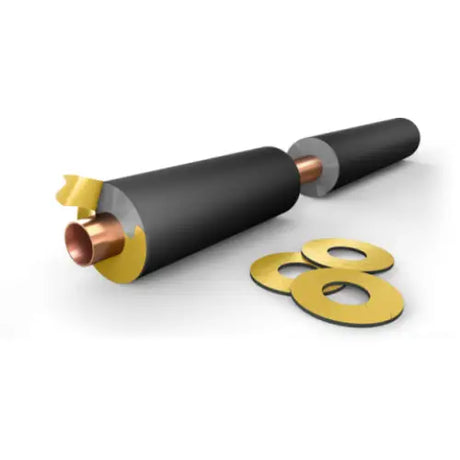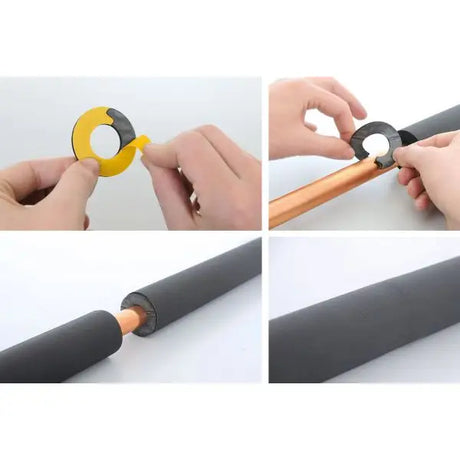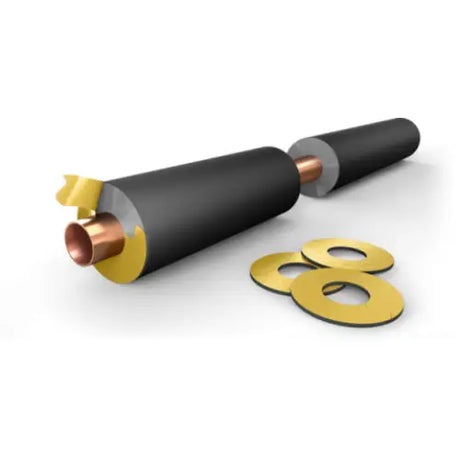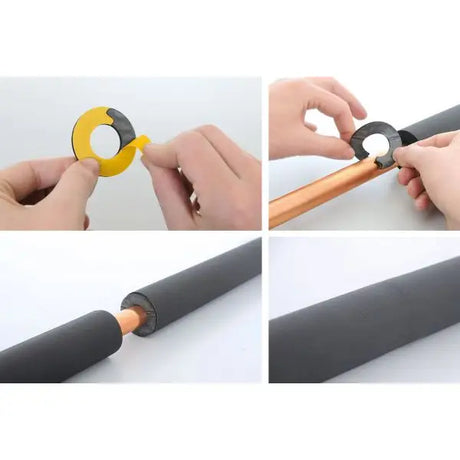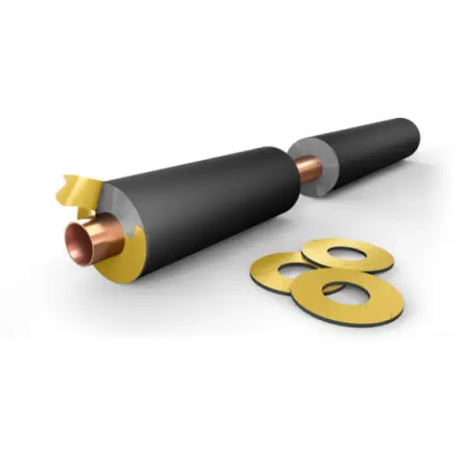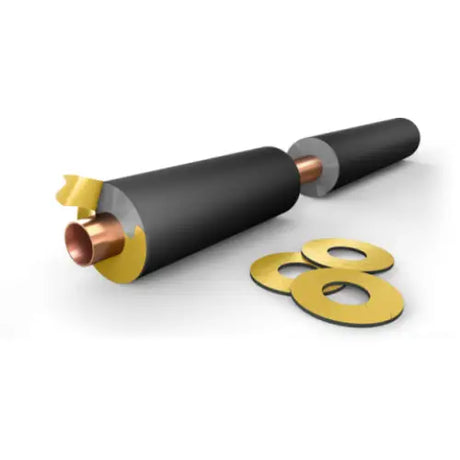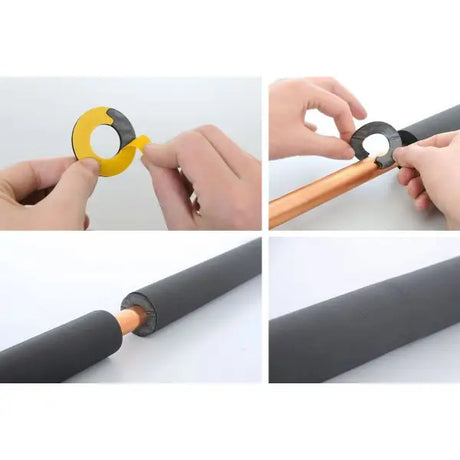Nowadays, people are thinking more about how to protect our environment. One area of focus is the materials we use day-to-day. Among these, the way we dispose of elastomeric foam is getting a lot of attention. This material's effect on our planet is significant. So, it's vital we get better at recycling it. This not only helps us follow rules but also protects the environment.
In Europe, folks who build or tear down structures face a big environmental challenge. They have to deal with a lot of plastic use and make sure it's disposed of correctly. With over 1.2 billion tonnes of waste coming from construction and demolition, and only some of it being recycled1, we need to pay more attention to materials like elastomeric foam. Right now, we don't focus on it as much as we should.
Recycling elastomeric foam has become crucial in today's green-focused world. This guide offers clear steps to do it in a way that's good for the planet. By recycling elastomeric foam properly, you're helping save resources and protect our environment.
Key Takeaways
- Recognising the environmental implications of improper elastomeric foam disposal
- Grasping the magnitude of recycling in the context of construction and demolition waste
- The intrinsic link between environmental responsibility and elastomeric foam recycling
- An overview of the eco-friendly strategies in managing elastomeric foam waste
- Insights into the challenges and opportunities in recycling elastomeric foam the UK
Understanding Elastomeric Foam and Its Environmental Impact
Elastomeric foam plays a key role in many industries thanks to its flexibility and insulating qualities. It makes up 67% of polyurethane produced in 20162. This material is crucial for things like cars and keeping buildings warm. In 2019, over 25 million metric tonnes were made worldwide. This was about 6% of all polymers produced that year2. The production of flexible polyurethane foams started with 45,000 metric tonnes in 19602. By the early 1980s, people used it for car gaskets in a huge leap forward2.
But, elastomeric foam's impact on the environment is not small. Its journey has been shaped by rules like the Montreal Protocol in the early 1990s. This banned harmful agents such as CFC-112. It led to the use of safer agents like carbon dioxide in North America and Europe by the late 1990s2. The ban on HFC-134a shows the fight against harmful practices is still going2.
Key materials for making polyurethane are di- and tri-isocyanates and polyols. Toluene diisocyanate (TDI) and methylene diphenyl diisocyanate (MDI) are top choices2. There are also aliphatic and cycloaliphatic isocyanates used for their colour stability. Polyols, which are polymers with lots of hydroxyl groups, are crucial for creating versatile polyurethane structures2.
Saint-Gobain Technical Insulation and Kaimann GmbH lead in environmental efforts. They have been focusing on sustainability since 19373. Saint-Gobain made €38.1 billion in 2020 and has over 167,000 employees in 72 countries. They plan to be carbon neutral by 20503. This shows their strong commitment to eco-friendly building materials3.
Companies like ISOPIPE S.A. are also doing their part. They operate on over 30,000 m2 and sell to more than 40 countries. Their ISOPIPE TC Flexible Elastomeric Foam Insulation is made mainly of synthetic rubber. It has 98.5% closed cells for better resource use4. They meet EN ISO standards and focus on recycling and saving energy4.
| Elastomeric Foam Application | Historical Context | Environmental Measures |
|---|---|---|
| Insulation Material | Produced since 1960 | 98.5% closed cells for efficiency |
| Automotive Gaskets | Used water-blown foams in 1980s | Shift to eco-friendlier blowing agents in the 1990s |
| General Polymer Applications | 67% of polyurethane produced in 2016 | Saint-Gobain aims for Carbon Neutrality by 2050 |
The clear connection between elastomeric foam and the environment requires sustainable methods in its making and disposal. As innovation grows and regulations get stricter, a future where elastomeric foam aligns with caring for the planet looks possible.
The Significance of Recycling Elastomeric Foam in the UK
The UK's push to recycle elastomeric foam is becoming crucial. This is due to the quick growth of polyurethane production and the problems it brings for sustainable waste management. With more Waste Electrical and Electronic Equipment (WEEE), we need good ways to get rid of elastomeric foam. This is important for saving the environment. We must look closely at the challenges and chances in recycling.
The Growth of Polyurethane Production and Its Challenges
Rigid foam insulation is key in insulation and construction. It helps save energy. But, its complexity makes recycling hard5. The UK is making more polyurethane. So, more elastomeric foam needs disposal when it's not useful anymore.
There are several kinds of rigid foam insulation like EPS and PIR. They work well in wet conditions but differ in recyclability5. Also, some foam insulation has additives like fire retardants and PFAS. These can harm the environment because they build up in nature5.
WEEE: A Rising Concern for Elastomeric Foam Disposal
More WEEE means new problems for disposing of elastomeric foam. Some insulation materials need to follow WEEE rules. This means they need special care to avoid releasing harmful substances5.
Getting and recycling foam from WEEE is hard. The issues come from both collecting it and contamination. Also, some insulants that resist fire or release gases are safety and environment concerns5.
The UK's polyurethane industry and waste systems must come up with new solutions. Companies like Isover are starting closed-loop recycling for construction waste6. They are focusing on sustainable practices. For example, Isover's glass wool product shows a commitment to recycling and efficiency6.
In conclusion, recycling elastomeric foam in the UK is very important for the environment. The different materials, the effects of WEEE, and the need for new recycling methods show we must innovate and work together in this area.
Recycling Elastomeric Foam: An Eco-Friendly Priority
The push towards eco-friendly recycling practices has grown. Elastomeric foam recycling is vital in this effort. It blends sustainability with economic benefits.
Unusual materials are looked at for insulation, like onion skins and peanut shells. Blends of concrete and recycled foams are also considered. These innovations highlight a shift towards diverse, sustainable insulation options7.
Eco-friendly efforts shine with metakaolin-based porous geopolymers. They use recycled wastes. Insulation from elastomeric waste residues showcases progress in turning pollutants into valuable insulators7.
https://www.youtube.com/watch?v=-7vmg1-KCJo
Sustainability offers both environmental and economic benefits. Using materials like cattail fibers for insulation shows promising results. It leads to gains in energy efficiency and material performance7. Fly ash boards, known for insulation properties, signal a move towards materials that perform well on multiple levels7.
To wrap up, eco-friendly recycling is transforming material use. Panels made from recycled cardboard are a case in point. They improve performance and show a deep commitment to the environment. Elastomeric foam recycling is a part of this major shift towards a greener, more efficient future in materials7.
Comparative Analysis of Elastomeric Foam Disposal Techniques
Managing elastomeric foam waste is a significant challenge due to its complexity and environmental impact. We need to thoroughly understand different disposal methods: landfill, incineration, and recycling. These methods help us assess their effects and efficiency.
Landfill vs Incineration vs Recycling
Landfills have been the go-to for disposing of waste. But elastomeric foam in landfills uses a lot of space, which is a problem. The harmful effects of waste management include chemicals leaking into the ground, causing long-term harm to the environment.
Incineration, on the other hand, cuts down the amount of waste. Yet, it can release dangerous gases that pollute the air and heat up the planet. Hence, recycling elastomeric foam becomes essential as it's a more sustainable choice. Recycling helps us avoid using new raw materials and reduces waste.
Harmful Effects of Inadequate Waste Management
The harmful effects of waste management are serious. Studies stress the need for better waste management systems. For example, 129 billion disposable face masks and 65 billion rubber gloves were thrown away worldwide by June 2020. This shows how important it is to manage our waste properly8.
The European Union has set goals to better recycle and reuse elastomeric products. They aimed to raise the recycling rate of waste tires from 80% in 2006 to 85% in 20158. Portugal's EPR system is a success, improving tire recycling rates from 69% to 98%8.
These facts show that recycling is better than using landfills or burning waste. Recycling leads to a greener and cleaner future.
| Country | Collected Waste Tires (tons) | Reuse & Recycling Rate (%) | Energy Recovery Rate (%) |
|---|---|---|---|
| Italy (2012) | 403,000 | 54.2 | 57.9 |
| Belgium | N/A | 85.0 | 15.0 |
| Poland (2014) | N/A | 24.6 | 76.3 |
| Japan (2020) | 937,000 | N/A | 65 |
Countries that focus on recycling are achieving great results. For example, Malaysia recycled around 245,000 tons of used tires in 2010. This shows how important recycling initiatives are for the future8. Japan, however, is focusing on recovering energy, managing to recover 65% of the 937,000 tons of End-of-Life Tires (ELTs) collected in 20208.
South Korea's Plastic Waste Control Plan from 2018 plans to cut plastic waste by at least 50%. This shows a strong effort to lessen environmental harm8. By understanding the harmful effects of waste management and using real data, we can improve waste management everywhere.
The numbers show that elastomeric waste is a big problem. For instance, Thailand exported about 30% of the world's natural rubber in 2020. This highlights how much material could end up as waste8. Experts predict that waste tires could reach 1.2 billion pieces per year by 2030. This calls for urgent action to find sustainable disposal methods for elastomeric foam8.
Recycling Elastomeric Foam: Process and Technologies
The process to recycle elastomeric foam is gaining momentum as a key part of eco-friendly waste management. This is especially true in the Polyurethane (PU) sector which is big globally. Asia is at the forefront, holding 45% of the market, with North America and Europe not far behind.9 Companies like Dow Inc., BASF SE, and Covestro AG are leading the charge. They are finding new ways to turn elastomeric foam into something useful instead of trash.9
| Material Composition | Properties Imparted |
|---|---|
| Oligomerols (approx. 2/3) | Elasticity and Softness |
| Isocyanates (MDI, TDI, HDI, IPDI) | Chemical structure |
| Catalysts (tertiary amines, trialkylphosphines, organotin compounds) | Speed of PU synthesis |
The elastomeric foam recycling process starts with collecting and sorting foam waste. This stage separates polyurethanes according to type. The foam's softness comes from oligomerols.9 Next, the process takes advantage of isocyanates and catalysts important for making PU.9 Then, advanced methods are used to turn the waste into something new.
Recycling technologies are becoming popular because they use waste to make new PU products. This trend supports growing environmental awareness and the move towards a circular economy. It helps reduce harmful gases and matches the European Union's Circular Economy Action Plan since 2015.9
As people want more sustainable products, the focus on recycling elastomeric foam with advanced technology is rising. This approach shows the industry's move towards being more eco-friendly. It combines care for the environment with good business practice.
Physical and Chemical Recycling Methods Explained
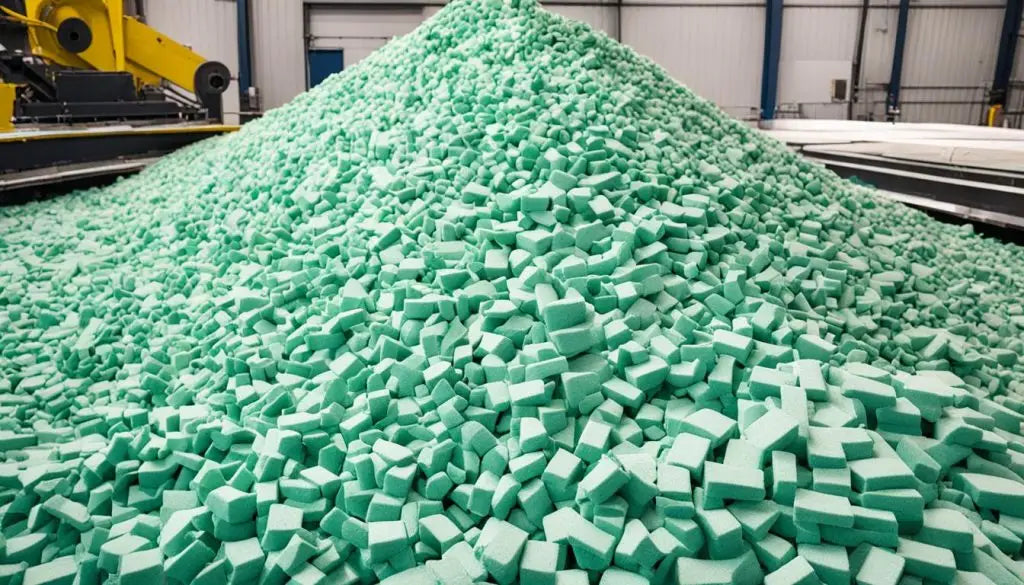
When we look at physical recycling and chemical recycling, it's key to see how each has evolved. Understanding both methods shows their pros and cons. This knowledge is vital for eco-friendly reuse of elastic foam.
Advantages and Disadvantages of Physical Recycling
Physical recycling stands out for its simple process, making material recovery straightforward. Yet, it faces hurdles like material wear or reclaiming issues. For certain foams, using rapeseed oil derivatives offers a greener option, though its use is limited and might affect quality10.
Innovations in Chemical Recycling Techniques
Chemical recycling presents a complex but promising field. Techniques like hot compression molding help in cost-effective material reuse. They show how materials like polyurethane can be efficiently repurposed10. At the same time, advancements in breaking down tough materials via enzymes suggest powerful new methods for recycling10.
| Recycling Method | Advantages | Disadvantages | Innovative Approaches |
|---|---|---|---|
| Physical Recycling | Operational ease, fast processing | Limited market use, potential downcycling | Enhancement with bio-based derivatives10 |
| Chemical Recycling | Creates high-quality materials, versatile applications | Complex processes, higher costs | Enzymatic hydrolysis tuning, hot compression molding10 |
Moreover, blending pyrolysis with combustion studies helps find eco-friendly techniques. This effort is backed by laws from the European Parliament and Council. They promote responsible waste management and recycling10.
In the shift towards chemical degradation, we see a clear move towards sustainability. This method offers a sustainable recycling strategy, changing our focus from discarding to reusing. This aligns with the goals set by the 2008 directive for better use of resources10.
In closing, both recycling types are valuable. But, the research highlighted here opens new paths for eco-friendly choices. This marks a shift towards a future where detailed knowledge of materials meets our broader environmental goals10.
Designing for Recyclability: The Role of Manufacturers
At the heart of fighting environmental harm is a key approach: design for recyclability. Manufacturers have a crucial role here. They make products that satisfy our needs and also promote sustainable product design practices. This part looks at how they can include recyclability in their designs, leading to better solutions for electronics.
Principles of Sustainable Product Design
Manufacturers adopting sustainable product design must follow important rules. They need to pick green materials, plan for easy disassembly, and consider a product's entire life cycle early on. These steps are essential to create products that are easy to recycle later, making use of old items to create new ones.
Creating Circular Solutions for Electrical and Electronic Equipment
Building circular solutions for electronics requires various efforts. It's about innovative design and setting up systems that move us from a throw-away culture to a circular one. Manufacturers must think about how products can be reused or materials recovered, helping to extend product life and cut down on rubbish.
To achieve a green future, manufacturers must focus on effective recycling plans. Understanding how to recover materials and making products easy to recycle can bring major benefits. This positions manufacturers as frontrunners in creating a sustainable future. The reference
| Design Principle | Advantages | Challenges |
|---|---|---|
| Material Selection | Reduces environmental footprint, Improves recyclability | Finding balance between performance and sustainability |
| Design for Disassembly | Facilitates recycling, Prolongs product life | May increase initial manufacturing complexity |
| Lifecycle Analysis | Informs sustainable decisions, Fosters innovation | Requires comprehensive data and may lengthen the design process |
In summary, adopting sustainable design is necessary for manufacturers to succeed in today's changing market. Embracing circular solutions not only aids the environment but also opens up new growth and innovation opportunities.
Advancements in Elastomeric Foam Recycling Technologies
The elastomeric foam recycling technologies have improved a lot lately. This is because of a worldwide move towards being sustainable and the circular economy idea11. Currently, the use of thermoplastic elastomers (TPEs) is around 680,000 tons each year since 1990, and it's still growing by about nine percent each year12. This growth shows how vital it is to find good ways to recycle them.
TPEs stand out because they have thermal properties and are stable materials. They can be shaped, pushed out, and used again like plastics12. They also don't need much energy to make and are easy to colour. This makes recycling TPEs good for the environment and saves money12.
New tech has made sorting and reprocessing in recycling better. One breakthrough is the use of labels that glow under certain lights to help pick out plastic waste11. Mechanical recycling is found to be better than other methods for many polymers. Hence, it's getting a lot of attention and funding now11.
| Technology | Application | Yield |
|---|---|---|
| Ru Nanoparticles on Carbon | Convert PE to Liquid Alkanes | 45% after 16 hrs11 |
| Ru-Supported Titania Catalyst | Deconstruct Polypropylene | 66-80% Oil Yields11 |
| Iridium-MACHO Catalysis | Convert Polyurethanes into Anilines and Polyols | High Yields11 |
| Acid Catalyst | Upsycle PS into Benzoic Acid, Formic Acid, Acetophenone | Effective11 |
Advancements in elastomeric foam recycling technologies need to be part of both old and new systems. It's important to consider how TPEs are used, from cars to healthcare. We have to ensure that there's a good way to manage these materials from start to finish12.
Looking to the future, there are many chances for growth. For example, ionic liquids might be the next big thing in breaking down polymers more efficiently11. With goals to cut down waste by 2030, as set by the UN, these updates in recycling are crucial. They help us meet our goals for a better planet11.
Recycling Elastomeric Foam: Maximising Material Recovery
Elastomeric foam recycling focuses on getting the most out of the material. Polyurethanes (PUs) make up 7.8% of all plastics in EU27 + 3 countries. This shows they are a big part of the market13. We use different ways to recycle and save the environment.
There are many methods to recycle polyurethanes, from basic to advanced13. We look at mechanical, physical, and feedstock recycling. These use processes to break down and rebuild materials. One method, hydrolysis, lets us replace up to 50% of original polyols with recycled materials in new foams13.
Maximising material recovery not only reduces our reliance on virgin resources but also minimises wastage, subsequently decreasing environmental pollution and promoting a circular economy.
Recycling elastomeric foams is important in many fields, like transportation. Polyurethane ties last over 50 years and can be reused14. They are more durable than traditional materials.
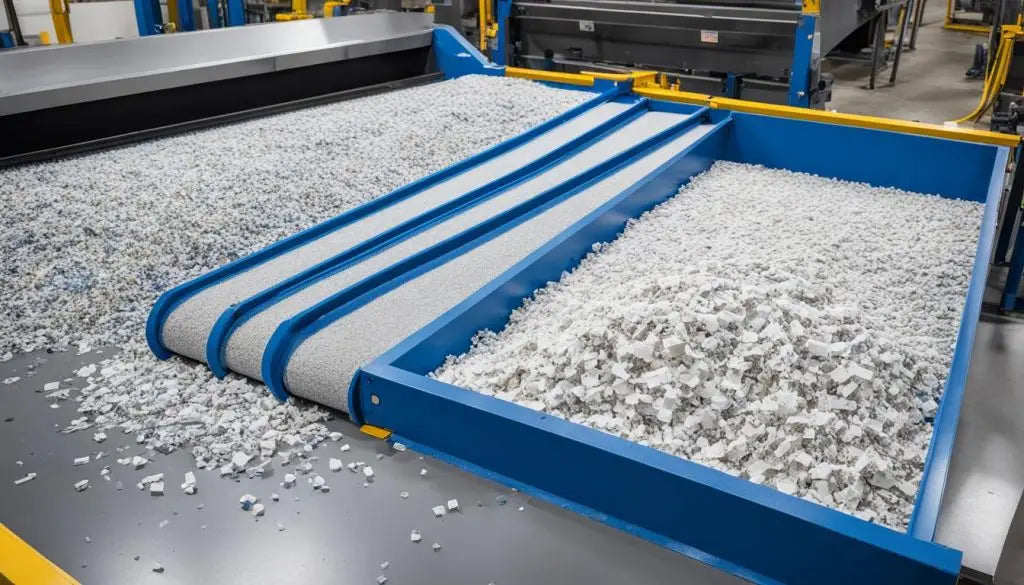
New recycling ways improve not just recovery, but product quality too. For example, polyurethane ties are stronger than wood after 15 years14. They also cost less to maintain and build for railways. These ties, lighter than concrete, are perfect for bridges and fast tracks14.
The versatility of polyurethane also shines in its adaptability, with ties made in many sizes, up to 9.60 meters long14.
| Recycling Strategy | Percentage Recovery | Application Sector |
|---|---|---|
| Hydrolysis | Up to 50% | Flexible & Rigid Foams |
| Mechanical | Varies | General PU Products |
| Feedstock | Dependent on process efficacy | Elastomer & Coatings |
The scope of elastomeric foam recycling and efficient material recovery keeps growing. New techniques and strategies show a big potential for change. They bring together economic benefits and the care for our environment.
Case Studies: Successful Elastomeric Foam Recycling Initiatives
Organisations worldwide are tackling elastomeric foam recycling issues. They're coming up with different methods for it. These methods have led to case studies that are examples for others.
One key example is making two types of polyurethanes (PUs) from recycled stuff. This includes one using recycled elastomeric PU and another using PU dust from making surf boards15. This way, it turns waste into useful materials again and supports a circular economy.
With the global demand for PU products expected to rise significantly, the need for recycling has never been clearer. This fact highlights how critical these recycling initiatives are.
By adding PU dust, the recycled foams become stronger and more resilient15.The outcomes of using recycled PU are shown in the following table:
| Material | Characteristics Enhanced | Percentage Improvement |
|---|---|---|
| Thermoplastic PU | Tensile Strength, Elongation at Break | Up to 15wt% Gly content15 |
| PU Foam | Density, Compressive Strength, Compressive Modulus, Resilience | Over 100% in strength, Over 200% in modulus15 |
Research suggests that 15 wt% glycolysated polyol is ideal in thermoplastic polyurethanes. This helps the industry improve recycling15.
Creating recycled PUs is not just good for the environment. It also moves us towards more sustainable materials that meet global standards.
Another big step is a project on self-healing thermoplastic materials. This project is looking into new ways to face recycling challenges and spotting new chances in this area16.
- Advancements in bio-based polyethylene and its recycling16
- Turning citrus waste into useful products, which shows how we can turn trash into treasures16
- Creating better bio-based elastomers, which could lead to more eco-friendly tyres16
To wrap it up, these initiatives are more than just studies. They demonstrate an eager and innovative effort to make materials more sustainable.
Collaboration and Policy: Shaping the Future of Foam Recycling
Looking at the data from 2019 to 2060, we see how crucial recycling and policies are. This includes how we use plastics, the waste we create, and its effect on our planet17. Universities like Leeds, DTU, and NILU17 help by providing detailed data. This makes it clear: we need to work together closely and follow strict European rules to protect the environment.
The OECD's ENV-Linkages model shows how our economy and environment are linked, focusing on plastic use in 201917. It tells us that being eco-friendly and cutting costs can go hand in hand17. This model reflects our aim to care for the planet and people alike.
European Regulations and Their Impact on Recycling
European rules have a huge impact on recycling. They shape how we track plastics' use and recycling17. We don't just look at how much is used but how well it's being reused. The methods used are complex, involving other models to understand economic and environmental changes17.
The Importance of Cross-Sector Collaboration
Working together across different areas is key for recycling progress. We use a detailed model to understand international trade17. This teamwork is not just about following rules. It's about doing actual, effective work to recycle more and waste less17.
To succeed, the foam recycling industry needs everyone to work together. This means governments, environmental groups, companies, and recyclers must all play their part17. Following economic trends helps us see how things change over time17. This reminds us that by working together, we can face challenges and build a greener future.
Conclusion
As we wrap up our journey through the complex world of recycling elastomeric foam, we highlight the shared duty we have. It's vital to adopt eco-friendly ways when getting rid of this material. Doing so not only helps our environment but is essential for its care.
Through looking at different ways to dispose of foam and new recycling methods, we've seen the path to saving materials. Recycling recycling elastomeric foam is key to cutting down waste and saving resources. This guide has shed light on the steps involved and pushed for innovation among makers and policy leaders.
In the end, the fate of our Earth relies on the eco choices we make now. It's a call to action for everyone in the UK to recycle responsibly and push for changes that support a sustainable material lifecycle. Let's work together to leave a healthier, stronger planet for those coming after us.
FAQ
Why is recycling elastomeric foam important?
Recycling elastomeric foam is crucial as it cuts down waste and helps in saving resources. It also reduces the harmful effects on our environment and health. Keeping elastomeric foam out of landfills lessens environmental damage.
What is elastomeric foam?
Elastomeric foam is a light, bendy material used for insulating. Being made from synthetic rubber, it's great for thermal and noise control. It's widely used in the HVAC, automotive, and construction sectors.
How is elastomeric foam used?
This foam is used in several ways, like insulating pipes and keeping buildings quiet. It helps in managing temperature in air systems and fridges too. It's also used in vehicles to dampen vibrations.
What are the environmental impacts of elastomeric foam?
Making and throwing away elastomeric foam pollutes and creates waste. If not disposed of properly, it can release dangerous chemicals. The production demands energy and resources, increasing carbon emissions.
How does recycling elastomeric foam contribute to sustainability?
Recycling this foam aids sustainability by cutting down waste and saving resources. It allows materials to be reused, reducing the need for new resources. This also lowers carbon emissions significantly.
What are the different methods of elastomeric foam disposal?
The main ways to dispose of elastomeric foam include landfill, burning, and recycling. Dumping and burning harm the environment, but recycling helps recover and reuse materials.
What are the benefits of recycling elastomeric foam?
Recycling elastomeric foam reduces waste and saves resources. It lessens environmental damage and can also create jobs. This promotes a circular economy, where materials are reused.
What is the process of recycling elastomeric foam?
The recycling process involves collecting, sorting, and reprocessing the foam. It's first gathered and cleaned of contaminants. Then, it's reprocessed into new raw materials through mechanical or chemical means.
What are the different recycling technologies for elastomeric foam?
Elastomeric foam is recycled through mechanical and chemical methods. Mechanical recycling turns the foam into small parts for reuse. Chemical methods break it down for new uses.
How can manufacturers design elastomeric foam products for recyclability?
Manufacturers can make elastomeric foam products more recyclable by choosing the right materials. They should think about how easy products are to take apart. Using recyclable materials helps too.
What are the latest advancements in elastomeric foam recycling technologies?
New technologies are improving how elastomeric foam is sorted and reprocessed. These include better ways to separate the foam and enhance recycled materials' quality.
How can material recovery be maximized in the recycling of elastomeric foam?
To get the most material back, we need better collection, sorting, and processing. Using the latest technologies can help recover more materials for reuse.
Are there any successful elastomeric foam recycling initiatives?
Yes, there are many effective elastomeric foam recycling programs worldwide. They show how groups can work together to recycle more and share what they learn.
How can collaboration and policy shape the future of foam recycling?
Working together is key for improving foam recycling. Laws and teamwork among businesses, recyclers, and governments encourage recycling. This leads to better recycling methods and tech.
Source Links
- https://www.acrplus.org/images/pdf/document142.pdf
- https://en.wikipedia.org/wiki/Polyurethane
- https://www.isover-technical-insulation.com/saint-gobain-technical-insulation
- https://api.environdec.com/api/v1/EPDLibrary/Files/b7987c2b-f64e-40d6-194d-08d9f9f51170/Data
- https://www.designingbuildings.co.uk/wiki/Types of rigid foam insulation
- https://www.saint-gobain.com/en/isover
- https://www.ncbi.nlm.nih.gov/pmc/articles/PMC6985380/
- https://link.springer.com/article/10.1007/s10163-022-01554-y
- https://www.mdpi.com/1996-1944/17/5/1013
- https://www.ncbi.nlm.nih.gov/pmc/articles/PMC7464512/
- https://www.ncbi.nlm.nih.gov/pmc/articles/PMC10598562/
- https://en.wikipedia.org/wiki/Thermoplastic_elastomer
- https://pubs.rsc.org/en/content/articlehtml/2024/gc/d3gc02091f
- https://www.polyurethanes.org/why-choose-it/sustainability-2/
- https://www.mdpi.com/2504-3900/2/23/1490
- https://www.ncbi.nlm.nih.gov/pmc/articles/PMC10819226/
- https://www.oecd-ilibrary.org/sites/5afebecf-en/index.html?itemId=/content/component/5afebecf-en

